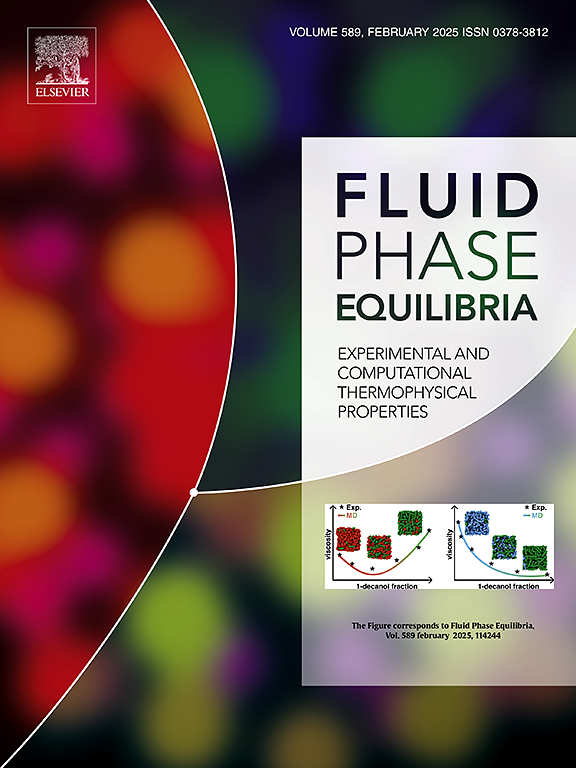A deep study on the phase behavior of the mixture CO2 – n-Hexadecane at 298.15 K: Miscibility window, mass barotropy, volumetric/saturation data, and separability of the phases
IF 2.7
3区 工程技术
Q3 CHEMISTRY, PHYSICAL
引用次数: 0
Abstract
This paper investigates the phase behavior of the CO2 - n-Hexadecane mixture at a temperature of 298.15 K for high CO2 concentrations. Under these conditions, the systems exhibit liquid-liquid equilibria at high pressures, accompanied by interesting phenomena, including a miscibility window and mass barotropy. The idea was to scrutinize the phase behavior of a simple compositional system displaying intricacies inherent to more complex CO2-dominant fluids. The literature gap addressed in this paper is the generated volumetric data, accompanied by a discussion of the results concerning the composition and density of the phases indirectly calculated using the volumetric method. The generated phase equilibrium (saturation and volumetric) and density data can be used in basic projects as a model mixture of CO2-rich phases for feeding porous or pipe multi-phase flow software simulations. The present investigation observed the separability of the phases under different conditions. The results suggest that interfacial tension is the main factor determining the degree of separability between these high-pressure liquid phases. Slight differences in density display a secondary, less pronounced impact on dispersibility; however, the interface tends not to resolve when the densities are similar, resulting in large stationary drops in this region.
298.15 K下CO2 -正十六烷混合物相行为的深入研究:混相窗口、质量正压性、体积/饱和度数据和相的可分性
本文研究了二氧化碳-正十六烷混合物在298.15 K高温下的物相行为。在这些条件下,系统在高压下表现出液-液平衡,并伴有有趣的现象,包括混相窗口和质量正压。这个想法是仔细检查一个简单的组成系统的相行为,显示更复杂的以二氧化碳为主的流体固有的复杂性。本文解决的文献缺口是生成的体积数据,并讨论了使用体积法间接计算的相的组成和密度的结果。生成的相平衡(饱和度和体积)和密度数据可作为富二氧化碳相的模型混合物用于基础工程,供多孔或管道多相流软件模拟使用。本研究观察了不同条件下相的可分性。结果表明,界面张力是决定高压液相分离程度的主要因素。密度的微小差异对分散性的影响是次要的,不太明显;然而,当密度相似时,界面倾向于不分解,导致该区域有较大的静止下降。
本文章由计算机程序翻译,如有差异,请以英文原文为准。
求助全文
约1分钟内获得全文
求助全文
来源期刊

Fluid Phase Equilibria
工程技术-工程:化工
CiteScore
5.30
自引率
15.40%
发文量
223
审稿时长
53 days
期刊介绍:
Fluid Phase Equilibria publishes high-quality papers dealing with experimental, theoretical, and applied research related to equilibrium and transport properties of fluids, solids, and interfaces. Subjects of interest include physical/phase and chemical equilibria; equilibrium and nonequilibrium thermophysical properties; fundamental thermodynamic relations; and stability. The systems central to the journal include pure substances and mixtures of organic and inorganic materials, including polymers, biochemicals, and surfactants with sufficient characterization of composition and purity for the results to be reproduced. Alloys are of interest only when thermodynamic studies are included, purely material studies will not be considered. In all cases, authors are expected to provide physical or chemical interpretations of the results.
Experimental research can include measurements under all conditions of temperature, pressure, and composition, including critical and supercritical. Measurements are to be associated with systems and conditions of fundamental or applied interest, and may not be only a collection of routine data, such as physical property or solubility measurements at limited pressures and temperatures close to ambient, or surfactant studies focussed strictly on micellisation or micelle structure. Papers reporting common data must be accompanied by new physical insights and/or contemporary or new theory or techniques.
 求助内容:
求助内容: 应助结果提醒方式:
应助结果提醒方式:


